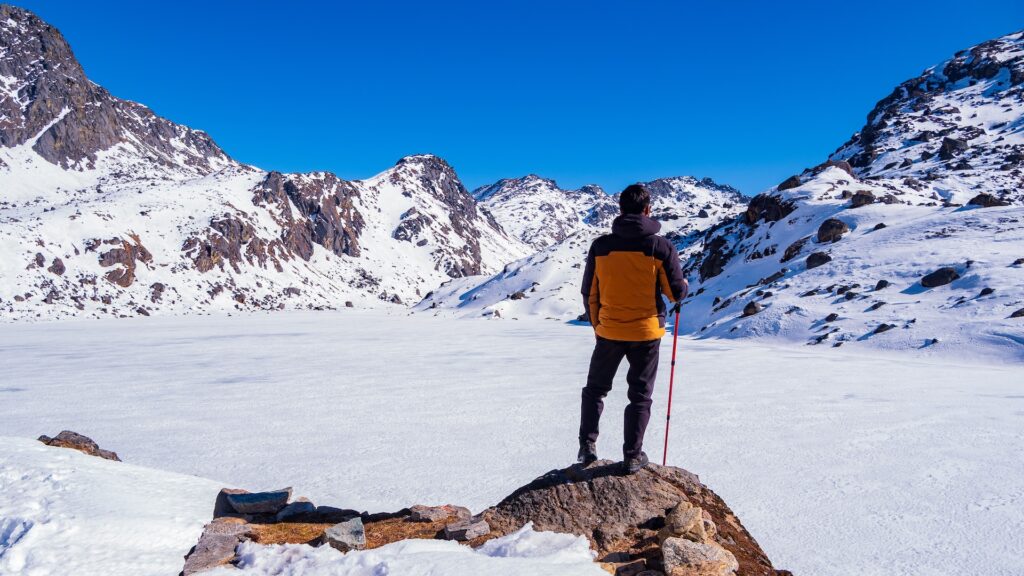Langtang And Gosaikunda Trekking
Langtang And Gosaikunda Trekking

Talk With Expert
- +977-1-5591234 / 9851104568
- info@prestigeadventure.com / pdamber@yahoo.com
OVERVIEW
Langtang and Gosaikunda Trek departs from SyabruBesi, a small village with breathtaking views of the Himalayas. The trail climbs gradually through terraced rice fields, subtropical forests and breathtaking waterfall views. Further, the road becomes steep and the Langtang valley widens with several Tamang villages and water mills along the way. The valley becomes wider after gradually climbing past yak grasslands and colorful prayer flags to reach Kyanjin village. You can climb KyanjinRi (4773 m) to enjoy splendid panoramic views of the Himalayas and the peaceful environment of the Langtang region. The view of Langtang Lirung’s beautiful ice faces and turbulent glaciers from kyanjinRi is stunning.
The walk will then return to Lama Hotel and follow the hill road to ThuloSyabru, where you will have the opportunity to learn about the culture, traditions and daily life of the Tamang ethnic community. Next, the trail passes through dense forests of hemlock, oak, fir and rhododendron to reach Sing Gompa, famous for its yak cheese factory in the Langtnag Valley. A steep ridge cutting through the rich, humid mountain forests on the northern slope will lead you to the beautiful sacred lake Gosaikunda, a high-altitude lake believed to have been created by Lord Shiva to quench thirst after drink poison. Langtang Gosaikunda Trek descends moderately following an easy path through the forest with stunning views of Numbur, JugalHimal and many other snow-capped peaks to reach GulphuBhanjyang. The journey will now leisurely pass through grasslands and cultivated fields to BurlangBhanjyang, from where you descend to Sundarijal and return to Kathmandu.
Trek Facts
No. of days: 17
Mode of trek: Camping
Starting point: Syabrubesi
Ending point: Sundarijal
Max. Elevation: 4380m
Season: Sept/Dec and Mar/May
Grade: Medium
Max. Walking: 6-7hrs.
Mode of travel: drive in/drive out
ITINERARY
-
Day 01 : Arrival Ktm, transfer to hotel BB
Once you are in the Kathmandu sky, you will be met by a panoramic vista of the snow-capped mountain ranges stretching below. At the airport, a representative from our office will greet you and drive you to your hotel. The representative will assist you in checking into the hotel of your choice. You will receive a briefing on your daily activities at the hotel.
-
Day 02 : Free day in Kathmandu, hotel BB
Since Nepal began welcoming tourists, Kathmandu, the historical and cultural center of the country, has become a well-liked travel destination. A beautiful fusion of Tibetan Buddhism, Hinduism, and Western influence can be seen in the city. A guided tour will be provided to the largest Buddhist stupa in Nepal, Boudhnath, as well as the most well-known Hindu shrine, Pashupatinath, which is devoted to Lord Shiva. Both sites are included as UNESCO World Heritage Sites. You go on a tour to Patan, also known as Lalitpur (the City of Artists), which is located 5 kilometers from Kathmandu. As you stroll through Patan Durbar Square, you can admire the magnificent architecture from the Malla era. The main draws in the plaza are the Mahaboudha Temple, Kumbeshwor Temple, Krishna Temple, and Golden Temple.
-
Day 03 : Drive Kathmandu to Syabrubesi
You travel by car to SyabruBesi for around nine hours from Kathmandu. You reach the picture-perfect settlements on the banks of the Trishuli River after traveling 30 kilometers. Additionally, the Annapurnas, Manaslu, Ganesh Himal, and the peaks of the Langtang region are all visible in the mesmerizing Himalayan landscape. Our Langtang Trek begins once we get to SyabruBesi.
-
Day 04 : Trek to Lama hotel
You cross the ridge on the main road to SyabruBesi and soon reach GhopchaKhola. Terraced fields and dense forests with diverse plant species such as oaks, maples, alders and bamboos open up. You can see yellow-throated swallows, wild boars, langur monkeys, red pandas and Himalayan black bears, which are endangered species in the Langtang region. Further on, the trail crosses a stream and a bridge. You pass by a number of small bhattis (tea shops). Continuing to climb steeply along the trail, you come to a steel suspension bridge at an altitude of 2000 meters. The route then crosses the north bank of the Langtang Khola amid breathtaking views of cascading waterfalls and opens up to a dense oak forest. Reaching an altitude of 2748 meters, you reach Lama Hotel, where you end your day’s hike.
-
Day 05 : Trek to Langtang
From Lama hotel, you continue to go up Langtang Khola. As the road progresses, it becomes steeper. You have the most exotic sights of Langtang Lirung, the highest peak in the Langtang region, peaking at 7246 m. The trail leads to a wooden bridge and climbing further you will encounter the lush grasslands of GhoraTabela at an altitude of 3000m. You will see some motels and police checkpoints. Further on, the road opens out into a wide valley with yak pastures and Tamang villages dotted with watermills and prayer wheels. You reach Langtang village after crossing a stream and reaching an altitude of 3500m. Langtang Village is the headquarters of Langtang National Park and has flat-roofed Tibetan-style houses, hotels, and farmland that produces buckwheat, potatoes, wheat, radish, barley, and more.
-
Day 06 : Trek to Kyanjing Gompa
The route from Muna to Singdun meanders gradually through lush yak meadows and intriguing traditional settlements. You ascend a moraine, pass a wooden cantilever bridge, and arrive in a broad valley. After climbing the mountain passes, you finally reach KyagjinGompa. The government-run cheese factory and a tiny monastery are both located in the Langtang Valley.
-
Day 07 : Rest day at Kyanjing Gompa for local exploration
You take a day off to adjust and get enough rest. You get to visit intriguing locations like a cheese factory and a monastery. You may climb KyangjinRi, which is at a height of 4773 meters and offers breathtaking views of the surrounding snow-capped mountains. To view the breathtaking mountain ridges and undulating glaciers, you can go along the moraine.
-
Day 08 : Trek to Lama hotel
You follow the path back to the Lama Hotel from Kyangjin. Retracing your steps, you go from Langtang village to GhoraTabela by following the Langtang Khola. After a quick lunch break, you resume the downward ascent to the Lama Hotel.
-
Day 09 : Trek to Thulo Syabru
The Lama Hotel is where you return to ThuloSyabru. You can ramble along the wavy route that leads to the settlement. You have the chance to learn about the Tamang community’s culture and customs thanks to this. You can also choose to do nothing more than unwind in the sunshine while admiring the spectacular Himalayan Mountains.
-
Day 10 : Trek to Shing Gompa
The route to Sing Gompa ascends through oak, fir, and rhododendron forests to reach a ridge, then cuts across the ridge top while remaining mostly level in the woods as it spans the valley’s head. At each fork, you choose the upward track to traverse another forested ridge. After crossing the head of a second valley, the trail continues until it reaches a last ridge at 3650 meters. About 100 meters down the trail to the left is Sing Gompa. The main draw of Chandan Bari, which also contains a number of hotels and a small cheese industry, is Sing Gompa.
-
Day 11 : Trek to Gosainkunda Lake
From Sing Gompa, you climb a ridge to reach the main Gosainkunda trail. The trail climbs steeply up the ridge and in some places reaches the top of the ridge. There are rich, wet montane forests on the northern slopes and dry scrub vegetation on the south. As the road climbs, you will have exceptional views from Langtang Valley to LangtangLirung. To the west, there are breathtaking views of Himalchuli, Ganesh Himal and Manaslu. Finally, the trail descends from the ridge to the first of the three lakes, SaraswatiKund. The second lake in the chain is called BhairabKund and the third lake is Gosainkunda. This lake is especially sacred and is a place of pilgrimage in the summer. Gosainkunda (Holy Shiva Lake) is a high altitude lake. According to Hindu legend, Lord Shiva himself created this elevated lake to quench thirst after drinking poison.
-
Day 12 : Trek to Ghopte
The trail ascends further through rocky terrain into Laurebina La Pass at 4610m after passing the northern side of Gosainkunda Lake. Despite being rocky, the trail is clearly marked with rock cairns. A ridge with a step trail running across it can be seen across the valley. The trail descends down the ridge through woodlands while weaving in and out of ravines over the valley’s head. The peak of the Tharedanda is made up of enormous cliffs that tower far above. At 3359 meters, the community of Gopte is just beyond.
-
Day 13 : Trek to Mangan Kharka
You continue to descend the hill, passing herders’ huts, juniper and rhododendron woodlands, and arriving at a stream before climbing to Tharepati, a cluster of herders’ huts at 3490m. In the direction of JugalHimal and Numbur in the SoluKhumbu, as well as down into the Helambu valley, the trail gradually descends through a forest of pine and rhododendron from Tharepati. We make our way slowly toward Helambu Valley from Langtang Valley.
-
Day 14 : Trek to GulphuBhanjyang
After a brief ascent to cross a ridge from ManganKharka, the trail descends into a forest with wonderful views of Numbur, JugalHimal, and numerous other snow-capped summits. The Tamang village of GulphuBhanjyang is reached by descending from Kutumsang after ascending to a pass at 2620 meters. From here, you may enjoy stunning views that reach as far east as Numbur and as far west as the Annapurnas and Manaslu. Gurungs and Tamangs live in harmony in the village of GulphuBhanjyang. There are a few government offices, along with stores and small eateries.
-
Day 15 : Trek to Chisopani
It is a short rise from GulphuBhanjyang to a pass at 2470 meters before descending to PatiBhanjyang, a sizable Tamang settlement. From here, Chisopani is a two-hour climb. A temple can be found on the high hill known as ChisopaniDanda, which is just a short distance above Chisopani. From here, you may enjoy the beautiful mountain views. The Manaslu range is visible as well as the mountains south of Everest.
-
Day 16 : Trek to Sundarijal & drive to Kathmandu
The trail ascends through an oak and rhododendron forest from Chisopani to BurlangBhanjyang after passing through meadows and farmland. From here, you can see Annapurna in the west, Ganesh Himal, and Numbur in the east, and everything in between. The Kathmandu Valley’s northern border is delineated by this peak. The entrance to the Shivapuri watershed and wildlife reserve is just after Chisopani. The path winds through the wilderness area before climbing a hill and descending to Mulkharka, where you can already see Kathmandu. You descend an interminable flight of stairs from Mulkharka to the reserve’s outlet and Sundarijal. Kathmandu is reached after a one-hour trip from Sundarijal.
-
Day 17 : Depart Kathmandu
From now till departure, you are free. As per your flight time, assistance will be provided to get you to Tribhuwan International Airport. Have a secure trip back home.
COST
WHAT IS INCLUDED
-
- 04 nights hotel in Kathmandu in 3 star standard on BB.
- All meals (Breakfast/lunch/dinner with tea\coffee).
- Accommodation in camping.
- A guide. cook, helper & porters.
- Ground transportation.
- Entry permits.
- All necessaries for Nepalese staffs (all meals, equipment’s, a).
WHAT IS EXCLUDED
-
- Lunch / dinner in Ktm stay.
- Any bar bills (alcoholic drinks, mineral water, cold drinks).
- Cigarettes.
- Clients personal insurance.
- Any kind of unforeseen expenses.
- Sleeping bag.
- Down jackets.
- Airport tax (Domestic / International) emergency rescue flight & expenses if require, etc.

